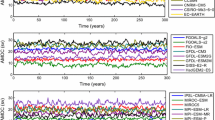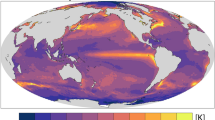Abstract
Under anthropogenic climate change it is possible that the increased radiative forcing and associated changes in mean climate may affect the “dynamical equilibrium” of the climate system; leading to a change in the relative dominance of different modes of natural variability, the characteristics of their patterns or their behavior in the time domain. Here we use multi-century integrations of version three of the Hadley Centre atmosphere model coupled to a mixed layer ocean to examine potential changes in atmosphere-surface ocean modes of variability. After first evaluating the simulated modes of Northern Hemisphere winter surface temperature and geopotential height against observations, we examine their behavior under an idealized equilibrium doubling of atmospheric CO2. We find no significant changes in the order of dominance, the spatial patterns or the associated time series of the modes. Having established that the dynamic equilibrium is preserved in the model on doubling of CO2, we go on to examine the temperature pattern of mean climate change in terms of the modes of variability; the motivation being that the pattern of change might be explicable in terms of changes in the amount of time the system resides in a particular mode. In addition, if the two are closely related, we might be able to assess the relative credibility of different spatial patterns of climate change from different models (or model versions) by assessing their representation of variability. Significant shifts do appear to occur in the mean position of residence when examining a truncated set of the leading order modes. However, on examining the complete spectrum of modes, it is found that the mean climate change pattern is close to orthogonal to all of the modes and the large shifts are a manifestation of this orthogonality. The results suggest that care should be exercised in using a truncated set of variability EOFs to evaluate climate change signals.









Similar content being viewed by others
Notes
The temperature anomaly T is expressed as a vector. Each element is a temperature at each spatial point on the model grid.
References
Barnett TP (1999) Comparison of near-surface air temperature variability in 11 coupled global climate models. J Climate 12:511–518
Barnston AG, Livezey RE (1987) Classification, seasonality and persistence of low-frequency atmospheric circulation patterns. Mon Wea Rev 115:1083–1126
Boer GJ, MacFarlane NA, Lazare M (1992) Greenhouse gas-induced climate change simulated with the CCC second-generation general circulation model. J Climate 5:1045–1077
Braganza K, Karoly DJ, Hirst AC, Mann ME, Stott P, Stouffer RJ, Tett SFB (2003) Simple indices of global climate variability and change: Part I—variability and correlation structure. Clim Dyn 20:491–502
Brandefelt J (2006) Atmospheric modes of variability in a changing climate. J Climate 19:5934–5943
Collins M, The CMIP Modelling Groups (2005) El Niño- or La Niña-like climate change? Clim Dyn 24:89–104
Corti S, Molteni F, Palmer TN (1999) Signature of recent climate change in frequencies of natural atmospheric circulation regimes. Nature 398:799–802
Dommenget D, Latif M (2002) A cautionary note on the interpretation of EOFs. J Climate 15:216–225
Fyfe JC, Boer GJ, Flato GM (1999) The Arctic and Antarctic Oscillations and their projected changes under global warming. Geophys Res Lett 26:1601–1604
Hurrell JW (1995) Decadal trends in the North Atlantic Oscillation: regional temperatures and precipitation. Science 269(5224):676–679
Jolliffe IT (2002) Principal component analysis, 2nd edn. Springer Series in Statistics. Springer, Berlin
Kuzmina SI, Bengtsson L, Johannessen OM, Drange H, Bobylev LP, Miles MW (2005) The North Atlantic Oscillation and greenhouse-gas forcing. Geophys. Res Lett 32(L04703)
Liang X.-Z, Wang W.-C, Dudek M (1996) Northern hemispheric interannual teleconnection patterns and their changes due to the greenhouse effect. J Climate 9:465–479
McAvaney BJ, Covey C, Joussaume S, Kattsov V, Kitoh A, Ogana W, Pitman AJ, Weaver AJ, Wood RA, Zhao Z-C (2001) Climate change 2001: the scientific basis. In: Houghton JT, Ding Y, Griggs DJ, Noguer M, van der Linden PJ, Dai X, Maskell K, Johnson CA (eds) Contribution of Working Group I to the Third Assessment Report of the Intergovernmental Panel on Climate Change, Chapter 8: Model Evaluation. Cambridge University Press, Cambridge, pp 471–523
Miller RL, Schmidt GA, Shindell DT (2006) Forced annular variations in the 20th century Intergovernmental Panel on Climate Change Fourth Assessment report models. J Geophys Res 111:D18101
Murphy JM, Sexton DMH, Barnett DN, Jones GS, Webb MJ, Collins M, Stainforth DA (2004) Quantification of modelling uncertainties in a large ensemble of climate change simulations. Nature 430:768–772
North GR, Bell TL, Cahalan RF, Moeng FJ(1982) Sampling errors in the estimation of empirical orthogonal functions. Mon Wea Rev 110:699–706
Osborn TJ (2004) Simulating the winter North Atlantic Oscillation: the roles of internal variability and greenhouse gas forcing. Clim Dyn 22:605–623
Paeth H, Hense A, Glowienka-Hense R, Voss R, Cubasch U (1999) The North Atlantic Oscillation as an indicator for greenhouse-gas induced regional climate change. Clim Dyn 15:953–960
Palmer TN (1999) A nonlinear dynamical perspective on climate prediction. J Climate 12:575–591
Pope VD, Gallani ML, Rowntree PR, Stratton RA (2000) The impact of new physical parameterizations in the Hadley Centre climate model: HadAM3. Clim Dyn 16:123–146
Stephenson DB, Hannachi A, O’Neill A (2004) On the existence of multiple climate regimes. Q J Roy Meteor Soc 130:583–605
Stephenson DB, Pavan V, Collins M, Junge MM, Quadrelli R, participating CMIP2 modelling groups (2006) North Atlantic Oscillation response to transient greenhouse gas forcing and the impact on European winter climate: a CMIP2 multi-model assessment. Clim Dyn 27:401–420
Stone DA, Weaver AJ, Stouffer RJ (2001) Projection of climate change onto modes of atmospheric variability. J Climate 14:3551–3565
Sutton RTS, Mathieu P-P (2002) Response of the atmosphere-ocean mixed layer system to anomalous ocean heat-flux convergence. Q J R Meteorol Soc 128(582):1259–1275
Terray L, Demory ME, Déqué M, de Coetlogon G, Maisonnave E (2004) Simulation of late-twenty-first-century changes in wintertime atmospheric circulation over Europe due to anthropogenic causes. J Climate 17:4630–4635
Thompson DWJ, Wallace JM (1998) The Arctic Oscillation signature in the wintertime geopotential height and temperature fields. Geophys Res Lett 25(9):1297–1300
Thompson DWJ, Wallace JM, Hegerl GC (2000) Annular modes in the extratropical circulation. Part II: Trends. J Climate 13:1018–1036
Trenberth KE (1995) Atmospheric circulation climate changes. Clim Change 31:427–453
Uppala SM, KÅ llberg PW, Simmons AJ, Andrae U, Da Costa Bechtold V, Fiorino M, Gibson JK, Haseler J, Hernandez A, Kelly GA, Li X, Onogi K, Saarinen S, Sokka N, Allan RP, Andersson E, Arpe K, Balmaseda MA, Beljaars ACM, Van De Berg L, Bidlot J, Bormann N, Caires S, Chevallier F, Dethof A, Dragosavac M, Fisher M, Fuentes M, Hagemann S, Hólm E, Hoskins BJ, Isaksen L, Janssen PAEM, Jenne R, Mcnally AP, Mahfouf J-F, Morcrette J-J, Rayner NA, Saunders RW, Simon P, Sterl A, Trenberth KE, Untch A, Vasiljevic D, Viterbo P, Woollen J (2005) The ERA-40 re-analysis. Q J Roy Meteo Soc 131:2961–3012
Wallace JM, Gutzler DS (1981) Teleconnections in the geopotential height field during the northern hemisphere winter. Mon Wea Rev 109:784–812
Williams KD, Keen AB, Crossley JF, Senior CA, Hewitt CD (2000) The slab model. Unified Model Documentation Paper 58, Met Office
Wu Q, Straus D (2004) AO, COWL and observed climate trends. J Climate 17:2139–2156
Acknowledgments
SK was supported by a University of Reading Research Endowment Trust Fund PhD studentship. MC was supported by the UK Department of the Environment, Food and Rural Affairs under Contract PECD/7/12/37, by the European Community ENSEMBLES (GOCE-CT-2003-505539) and DYNAMITE (GOCE-003903) projects under the Sixth Framework Programme. Access to the ECMWF ERA-40 dataset kindly supplied by the British Atmospheric Data Centre.
Author information
Authors and Affiliations
Corresponding author
Appendix
Appendix
To determine the impact of not including a dynamical ocean we compare the modes of MSLP from a 600-year control run of HadCM3. HadCM3 has a dynamic ocean model coupled to HadAM3; the same atmosphere model used in HadSM3, with the same atmospheric resolution. By comparing the EOFs produced it gives us some idea about how the dynamic ocean is affecting the modes of variability.
EOFs of MSLP were produced from a 600-year sample from a long equilibrium run of HadCM3 and are shown in Fig. 10; the first three EOFs are well separated. Each of the first six EOFs is similar to the corresponding EOF from HadSM3 (Fig. 3) with each EOF having correlation coefficients over 0.7. By including the dynamic ocean the fraction of variance explained by each mode is slightly altered. This may be due to the fact that the ocean adds some long-term memory to the system and therefore affects the low frequency variability of the system. The results show that the inclusion of the dynamic ocean model does not alter the spatial patterns of variability produced for the control climate. The dynamic model does increase the importance of the leading two modes for explaining the variance in the climate system. The top two modes of HadCM3 explain 45.6% of the variance compared to 35.2% for the top two modes of HadSM3.
As for Fig. 3 except for Coupled Atmosphere–Ocean GCM HadCM3
We also consider the modes of SAT variability within HadCM3; the results are shown in Fig. 11; with the first three EOFs being well separated. The first six EOFs for HadCM3 are also similar to those found in HadSM3 (see Fig. 1) but with different ordering, with EOFs (as defined by HadSM3) 4 and 5 being more dominant in HadCM3 analysis than EOFs 2 and 3. The SAT EOFs of HadSM3 are slightly closer in ordering to the EOFs of the ERA-40 data set. This is likely to be because the SSTs in HadSM3 are constrained to be close to climatological values because of the heat fluxes; HadCM3 runs without flux adjustments to the surface and is known to develop biases in ocean temperature (see McAvaney et al. 2001). We therefore expect the EOFs of the temperature field of HadSM3 are closer to observations.
As for Fig. 1 except for HadCM3
Rights and permissions
About this article
Cite this article
Keeley, S.P.E., Collins, M. & Thorpe, A.J. Northern hemisphere winter atmospheric climate: modes of natural variability and climate change. Clim Dyn 31, 195–211 (2008). https://doi.org/10.1007/s00382-007-0346-6
Received:
Accepted:
Published:
Issue Date:
DOI: https://doi.org/10.1007/s00382-007-0346-6






